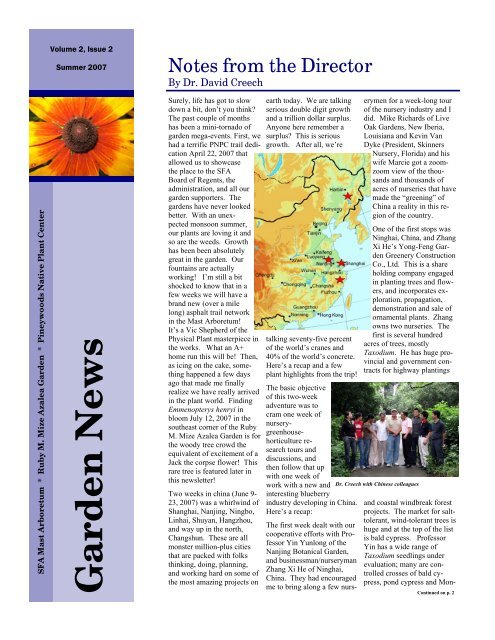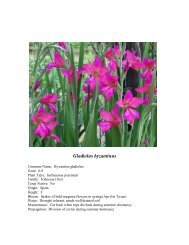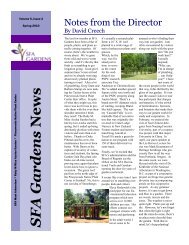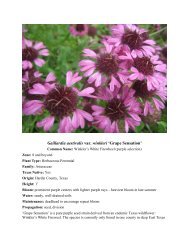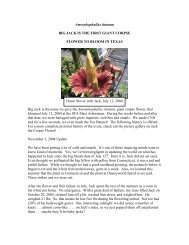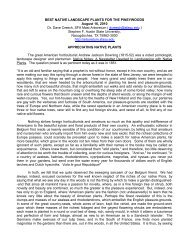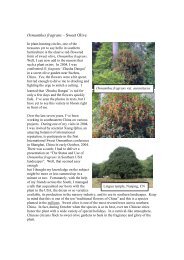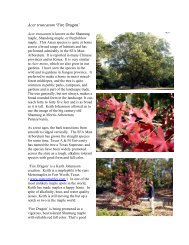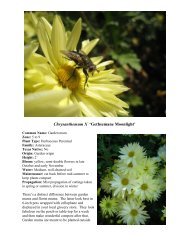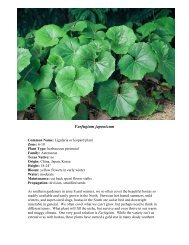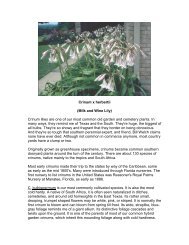Garden News - SFA Gardens - Stephen F. Austin State University
Garden News - SFA Gardens - Stephen F. Austin State University
Garden News - SFA Gardens - Stephen F. Austin State University
You also want an ePaper? Increase the reach of your titles
YUMPU automatically turns print PDFs into web optimized ePapers that Google loves.
<strong>SFA</strong> Mast Arboretum * Ruby M. Mize Azalea <strong>Garden</strong> * Pineywoods Native Plant Center<br />
Volume 2, Issue 2<br />
Summer 2007<br />
<strong>Garden</strong> <strong>News</strong><br />
Notes from the Director<br />
By Dr. David Creech<br />
Surely, life has got to slow<br />
down a bit, don’t you think?<br />
The past couple of months<br />
has been a mini-tornado of<br />
garden mega-events. First, we<br />
had a terrific PNPC trail dedication<br />
April 22, 2007 that<br />
allowed us to showcase<br />
the place to the <strong>SFA</strong><br />
Board of Regents, the<br />
administration, and all our<br />
garden supporters. The<br />
gardens have never looked<br />
better. With an unexpected<br />
monsoon summer,<br />
our plants are loving it and<br />
so are the weeds. Growth<br />
has been been absolutely<br />
great in the garden. Our<br />
fountains are actually<br />
working! I’m still a bit<br />
shocked to know that in a<br />
few weeks we will have a<br />
brand new (over a mile<br />
long) asphalt trail network<br />
in the Mast Arboretum!<br />
It’s a Vic Shepherd of the<br />
Physical Plant masterpiece in<br />
the works. What an A+<br />
home run this will be! Then,<br />
as icing on the cake, something<br />
happened a few days<br />
ago that made me finally<br />
realize we have really arrived<br />
in the plant world. Finding<br />
Emmenopterys henryi in<br />
bloom July 12, 2007 in the<br />
southeast corner of the Ruby<br />
M. Mize Azalea <strong>Garden</strong> is for<br />
the woody tree crowd the<br />
equivalent of excitement of a<br />
Jack the corpse flower! This<br />
rare tree is featured later in<br />
this newsletter!<br />
Two weeks in china (June 9-<br />
23, 2007) was a whirlwind of<br />
Shanghai, Nanjing, Ningbo,<br />
Linhai, Shuyan, Hangzhou,<br />
and way up in the north,<br />
Changshun. These are all<br />
monster million-plus cities<br />
that are packed with folks<br />
thinking, doing, planning,<br />
and working hard on some of<br />
the most amazing projects on<br />
earth today. We are talking<br />
serious double digit growth<br />
and a trillion dollar surplus.<br />
Anyone here remember a<br />
surplus? This is serious<br />
growth. After all, we’re<br />
talking seventy-five percent<br />
of the world’s cranes and<br />
40% of the world’s concrete.<br />
Here’s a recap and a few<br />
plant highlights from the trip!<br />
The basic objective<br />
of this two-week<br />
adventure was to<br />
cram one week of<br />
nurserygreenhousehorticultureresearch<br />
tours and<br />
discussions, and<br />
then follow that up<br />
with one week of<br />
work with a new and<br />
interesting blueberry<br />
industry developing in China.<br />
Here’s a recap:<br />
The first week dealt with our<br />
cooperative efforts with Professor<br />
Yin Yunlong of the<br />
Nanjing Botanical <strong>Garden</strong>,<br />
and businessman/nurseryman<br />
Zhang Xi He of Ninghai,<br />
China. They had encouraged<br />
me to bring along a few nurs-<br />
erymen for a week-long tour<br />
of the nursery industry and I<br />
did. Mike Richards of Live<br />
Oak <strong>Garden</strong>s, New Iberia,<br />
Louisiana and Kevin Van<br />
Dyke (President, Skinners<br />
Nursery, Florida) and his<br />
wife Marcie got a zoomzoom<br />
view of the thousands<br />
and thousands of<br />
acres of nurseries that have<br />
made the “greening” of<br />
China a reality in this region<br />
of the country.<br />
One of the first stops was<br />
Ninghai, China, and Zhang<br />
Xi He’s Yong-Feng <strong>Garden</strong><br />
Greenery Construction<br />
Co., Ltd. This is a share<br />
holding company engaged<br />
in planting trees and flowers,<br />
and incorporates exploration,<br />
propagation,<br />
demonstration and sale of<br />
ornamental plants. Zhang<br />
owns two nurseries. The<br />
first is several hundred<br />
acres of trees, mostly<br />
Taxodium. He has huge provincial<br />
and government contracts<br />
for highway plantings<br />
Dr. Creech with Chinese colleagues<br />
and coastal windbreak forest<br />
projects. The market for salttolerant,<br />
wind-tolerant trees is<br />
huge and at the top of the list<br />
is bald cypress. Professor<br />
Yin has a wide range of<br />
Taxodium seedlings under<br />
evaluation; many are controlled<br />
crosses of bald cypress,<br />
pond cypress and Mon-<br />
Continued on p. 2
Notes from the Director—cont. from page 1<br />
tezuma cypress. This native of the USA<br />
and Mexico has been in China over 100<br />
years and in the last fifty years, the Chinese<br />
have multiplied it into the millions. Along<br />
Mike Richards is impressed with bald cypress selections<br />
the way, breeding programs have introduced<br />
a number of selections that have<br />
found great favor. One was Z302, a baldcypress<br />
X Montezuma cypress cross, which<br />
was subsequently named ‘Nanjing Beauty’<br />
as a collaborative effort between <strong>SFA</strong> and<br />
the Nanjing Botanical <strong>Garden</strong>. At Yong-<br />
Feng Nursery, the blocks of ‘Nanjing<br />
Since our big “garden party” with the<br />
Azalea Society of America members in<br />
March and the installation of the signs in<br />
each bed, there’s been a little more time to<br />
spend noticing special features in the garden.<br />
With more than 520 different cultivars<br />
of azaleas, we really do have a long bloom<br />
period. The Huang hybrids in Bed 31 usually<br />
begin blooming in mid-February and<br />
our Satsuki begin in May.<br />
Satsuki azaleas are very old cultivars,<br />
which the Japanese have been selecting and<br />
breeding for centuries. The first book ever<br />
written about them was published in Japan<br />
in 1692 and was called The Brocade Pillow.<br />
This title is very descriptive, highlighting<br />
the highly decorative aspect of these<br />
interesting evergreen azaleas. Satsuki frequently<br />
exhibit highly varied flower forms<br />
and produce “branch sports” with unusual<br />
streaks, flecks, and alternate flower colors,<br />
all on the same plant. These azaleas could<br />
fill an important gardening function in<br />
small American gardens. If you could have<br />
many colors in a small garden space, such<br />
as a patio or condo garden, why not select a<br />
Page 2<br />
Beauty’ were totally uniform, totally dark<br />
green, and totally knockouts. Mike Richards,<br />
a bald cypress enthusiast, came away<br />
shaking his head in amazement. Blocks of<br />
other advanced selection material caught<br />
our eye. T27 and T140 looked good. T1<br />
was a standout and Professor Yin’s favorite<br />
for growth rate, form, and ease of cutting<br />
propagation.<br />
A couple of other high spots included seeing<br />
a field of Hibiscus X ‘Moy Grande’ at<br />
the nursery, all propagated from a few cut-<br />
Professor Yin Yunlong gives the thumbs up for the T1<br />
bald cypress selection<br />
Long Blooming Ruby M. Mize Azalea <strong>Garden</strong><br />
By Barb Stump<br />
Satsuki? We had several for sale at the<br />
Spring <strong>Garden</strong> Gala and will be looking for<br />
more for future sales. You can see ours in<br />
Rhododendron ‘Frosted Orange’<br />
Beds 4 (on the eastern side of the garden)<br />
and 17 (on the western side).<br />
For example, May 17 ‘Gunbi’ (Beauty of<br />
the group in Japanese) a sport of ‘Gumpo’<br />
was in full bloom, with 1-1/2 to 2-inch<br />
white flowers that were heavily speckled or<br />
striped as well as some flowers that are all<br />
deep red. June 6 ‘Tsuyu no hikari’ (Light<br />
of the rainy season) bloomed, with 2-1/2 to<br />
tings way back in 2003. Another surprise,<br />
A field of ‘Moy Grande’ hibiscus<br />
the sweet, delightful taste of Myrica rubra,<br />
which is cultivated in small hillside orchards<br />
almost everywhere. A big Schima<br />
in full bloom bowled me over. A field of<br />
<strong>Garden</strong>ias near Hangzhou grown solely for<br />
perfumery was another surprise; this area<br />
wants to be an inland bamboo “sea” and<br />
<strong>Garden</strong>ias are actually weeds! As usual, I<br />
returned from China jetlagged, a bit confused<br />
and disoriented, and kind of grumpy.<br />
My staff says that means I’m back to normal!<br />
Until later, keep planting!<br />
3-inch white flowers. Both are slow growing<br />
and compact in habit (typically under<br />
two feet tall).<br />
American azalea breeders have used Satsuki<br />
in their breeding programs to delay<br />
bloom time and add color. Two examples<br />
were in bloom May 17: ‘Painted Tips’ is<br />
Back Acres hybrid. Developed by B.Y.<br />
Morrison of Pass Christian, Mississippi,<br />
these hybrids are known for their heavy<br />
foliage texture and tolerance for high summer<br />
heat. One of the parents is Satsuki<br />
‘Shinnyo no tsuki’ (Eternal Moon). The 2-<br />
to 3-inch blooms are off-white with vivid<br />
pink petal tips. This is a low-spreading<br />
azalea that only gets 20 inches tall in 10<br />
years.<br />
‘Frosted Orange’ was developed by James<br />
Harris of Lawrenceville, Georgia, using<br />
Satsuki ‘Bunka’ (Cultured) as one of the<br />
parents. This evergreen azalea has 3-1/2<br />
inch white flowers with strong reddish orange<br />
borders. Bed 5 has a large collection<br />
of these that was in full bloom June 6. They<br />
are near mature height at 30 inches.<br />
GARDEN NEWS
PNPC <strong>Garden</strong> Report<br />
By Greg Grant<br />
We’ve been blessed with rain this summer<br />
which is good or bad depending whether<br />
you’re standing on the bank or in the middle<br />
of the stream. Of course it made lots of<br />
hay for my dad’s cows but unfortunately<br />
lots of weeds for the PNPC. It would be<br />
nice if they were native weeds but they<br />
aren’t. Of course the worst weeds of all we<br />
have at the PNPC are in the Tucker Woods<br />
with Chinese privet topping the list. We<br />
also have a good deal of Japanese honeysuckle,<br />
Chinaberry, and Chinese tallow as<br />
well. It’s going to take a monumental effort<br />
or perhaps divine intervention to get<br />
these invasive exotics under control. Continuous<br />
cutting and herbicide are probably<br />
our only hope. Perhaps we can form an<br />
anti-privet brigade. Opening up the understory<br />
will sure give our wild blue hyacinths<br />
(Camassia scilloides) room to breathe and<br />
grow. It’s actually a prairie wildflower, so<br />
there’s no such thing as too much light for<br />
it.<br />
Many thanks to Nina Ellis and her band of<br />
“wild women” volunteers for helping us<br />
reclaim the xeric bed from the weeds.<br />
Since they are from the western fringes of<br />
East Texas they are uniquely qualified to<br />
tackle this sandy oasis. Student worker<br />
Bryan Deak has also adopted this bed.<br />
After the hurricane and some neglect,<br />
things had gotten a bit out of control.<br />
Unfortunately trying to duplicate a natural<br />
bare sandy xeric clearing (no mulch) means<br />
weeds are quick to grow. We removed the<br />
VOLUME 2, ISSUE 2<br />
irrigation there to make it truly an upland<br />
xeric site. We’ve also removed the water<br />
guzzlers and swamp dwellers and added<br />
some new stuff, including Pinus palustris,<br />
Aesculus glabra arguta, Monarda lindhiemeri,<br />
variegated Capsicum annuum var.<br />
glabriusculum, Yucca recurvifolia, and<br />
Yucca filamentosa ‘Color Guard’. We’re<br />
also trying to establish an edging of Texas<br />
trailing phlox (Phlox nivalis ssp. texensis).<br />
According to friend and neighbor Diana<br />
Walker, Mrs. Tucker was quite fond of<br />
thrift (Phlox subulata) a southeastern lookalike.<br />
Plans are to add Dr. Parsons’ collection<br />
of Salvia greggii. He needs help<br />
figuring out which ones are different and<br />
which ones are the same. He’s trying to<br />
relocate those selections introduced from<br />
Mexico by the late great Lynn Lowry.<br />
They’ll just be temporary until we can provide<br />
proper identification for Dr. Parsons.<br />
I would LOVE to have more volunteers if<br />
anybody is up to it. Ultimately I’d like to<br />
have a “curator” for each display bed. With<br />
40 acres and only part time student help,<br />
there’s no way we can get the place into<br />
shape without like-minded volunteers.<br />
The rain also brought out the golden chanterelle<br />
mushrooms (Cantharellus cibarius)<br />
in the Tucker Woods. Apparently there’s a<br />
large industry harvesting and selling these<br />
in the Northwest. Although Elyce didn’t<br />
think they were so tasty I managed to eat<br />
them every day for a week in late June.<br />
What’s blooming in the garden?<br />
One of the highlights at the PNPC this<br />
spring was watching a pileated woodpecker<br />
and a redheaded woodpecker fight over the<br />
same big dead pine for nesting cavity<br />
rights. I’m a lifelong fan of woodpeckers.<br />
Don’t tell my bluebirds! After growing up<br />
with redheaded woodpeckers in the post<br />
oaks at my Granny’s house in Arcadia, they<br />
went missing for the last decade or so. But<br />
for some reason they have shown back up<br />
in full force this year, not only at home and<br />
the PNPC but even in downtown Center.<br />
Most will agree that the hurricane was good<br />
for the woodpeckers.<br />
Please do what you can to save and protect<br />
any wild spaces that you have under your<br />
control. Unfortunately there are precious<br />
too few spaces where our God-given diversity<br />
of trees, wildflowers, and wildlife can<br />
grow naturally any more. I was very saddened<br />
this spring to see the only stands of<br />
our drooping purple cone flower<br />
(Echinacea sanguinea) and wild blue larkspur<br />
(Delphinium carolinianum) mowed<br />
down before finishing blooming along the<br />
roads in Arcadia. There are darned few<br />
places left for our East Texas prairie flowers<br />
to grow any more that aren’t grazed,<br />
mowed, or paved. We live in a unique spot<br />
in the country where we have botanical<br />
representatives from Canada, Appalachia,<br />
the Great Plains, the Tropics, and the Desert<br />
Southwest. It’s a shame not to pass<br />
this diversity on to future generations. Until<br />
next time, keep Texas wild!<br />
Page 3
PNPC Update<br />
By Dr. David Creech<br />
Dr. Baker Patillo and Ms. Valerie Ertz cut the ribbon<br />
at the PNPC trails dedication<br />
On April 22, 2007, the Pineywoods Native<br />
Plant Center hosted the dedication of our<br />
amazing 2.2-mile trail network and kicked<br />
off a campaign to fund the Environmental<br />
Education Center. It was a perfect night.<br />
Our guests included the <strong>SFA</strong> Board of Regents,<br />
the <strong>SFA</strong> administration, our board of<br />
advisors, and an army of supporters, volunteers<br />
and staff. While Dave Creech, James<br />
Page 4<br />
Kroll, and Mike Legg enjoyed a little time<br />
at the microphone, it was up to <strong>SFA</strong> President<br />
Baker Patillo and Valerie Ertz, Chairman<br />
of the Board of Regents, to handle the<br />
ribbon cutting. Guests enjoyed an interpretive<br />
stroll in the forest led by Elyce Rodewald<br />
and Mike Legg and learned about the<br />
PNPC, the trails, and the long range vision<br />
for this wonderful garden. A first-class<br />
dinner was followed by a presentation on<br />
the PNPC—a Dave Creech where-it’s been,<br />
where-it-is, to where-it’s-going moment.<br />
Larry Greer and the Shades of Blue Jazz<br />
Band provided the background music for a<br />
magical evening, which even included the<br />
song of a distant chuck-will’s-widow in our<br />
forest.<br />
Development Report<br />
The George and Fay Young Foundation<br />
recently awarded us a $12,500 grant for a<br />
“PNPC—Raising Awareness Program,”<br />
with two elements: completion of signage<br />
all along the PNPC trails and a “Best of the<br />
A Schima Experience in China<br />
By Dr. David Creech<br />
We’ve enjoyed Schima here and there in the<br />
Mast Arboretum and Ruby M. Mize Azalea<br />
<strong>Garden</strong> for many years. They’re attractive<br />
and durable small evergreen trees. Schima<br />
is in the Theaceae family, which means it’s<br />
kin to the camellia. It sports dark-green,<br />
bold, elliptic leaves and a show of summertime<br />
white flowers. While we have accessions<br />
that include S. argentea, S. wallichi, S.<br />
superba, and S. remoto-serrata, most botanists<br />
lump them all under S. wallichi. In<br />
spite of that, no one denies that there’s considerable<br />
variability in leaf size, tree form,<br />
and flowering. While it can reach over 100’<br />
in its home in China, Schima in our area<br />
might reach 20’ to 40’ in that many years.<br />
On a recent trip to China, I was just plain<br />
lucky to catch the species in full bloom,<br />
June 17, 2007, on a mountain road near<br />
Linhai, part of the mountainous subtropical<br />
lands near the coast. The region normally<br />
enjoys good summer rains, but springs can<br />
bring extended dry spells. Some spots experience<br />
freezes and some do not with microclimates<br />
dominating here and there. In<br />
the mountains, the natural forest cover of<br />
the region depends, of course, on elevation,<br />
aspect, and how much human interaction is<br />
going on. In many areas, it’s a broad swath<br />
of factories, businesses, apartments, road<br />
and tunnel and rail projects, all quite land<br />
changing. There are other areas – wild<br />
lands, if you will, where the native vegetation<br />
has been given a chance. The diversity<br />
really is amazing. Loropetalum and <strong>Garden</strong>ias<br />
are weeds here! Cunninghammia,<br />
China fir, dominates the mid and upper<br />
slopes. Bamboo wants to own the place. In<br />
a wide variety of habitats, Schima seems to<br />
survive quite well in forest edges, bar<br />
ditches, roadsides, and fence rows. To me<br />
it looked like a durable plant in a tough<br />
landscape. The white flowers are axillary<br />
but mostly subterminal and the blooms feature<br />
a showy center of bright yellow anthers.<br />
Mildly fragrant, the flowers were<br />
caught just coming into full bloom in mid-<br />
June in central China, and, to my surprise,<br />
the same species was in full flower June<br />
24 th in our garden – that’s about the same<br />
time. I’m not sure how significant that is,<br />
but I liked the idea. Hardiness remains a<br />
question mark simply because we’ve tested<br />
our trees only into the mid-teens. We need<br />
Best Native Plants <strong>Garden</strong>” to be designed<br />
by David and Janet Creech. Elyce Rodewald<br />
and Greg Grant have been working on<br />
the content of these signs, with advice from<br />
board member Dr. Mike Legg. The new<br />
garden will be created on a sunny knoll on<br />
the northern edge of the PNPC property and<br />
will emphasize use of colorful native perennials,<br />
shrubs, and trees.<br />
Firewise Landscape Exhibit<br />
Greg, Elyce and the PNPC student crew<br />
completed work on the Firewise Landscape<br />
Educational Exhibit this spring. Original<br />
artwork by local artist Bruce Cunningham<br />
shows examples of plants that will slow or<br />
even extinguish a wildfire, plants to avoid<br />
and how residential homeowners can create<br />
a 30-foot “defensible space” around their<br />
homes. When you visit the PNPC, be sure<br />
to look for firewise plants and new signage,<br />
in the “backyard” of the Tucker House.<br />
This public awareness project was funded<br />
by the Texas Forest Service through their<br />
some single-digit events to get a better feel<br />
for adaptation in southern landscapes.<br />
Our conclusion: This an interesting plant,<br />
one rarely encountered in southern gardens.<br />
It appears to have horticultural potential<br />
across a wide band of the South. Dr. Tom<br />
Ranney of North Carolina <strong>State</strong> <strong>University</strong><br />
has crossed Franklinia (also in the<br />
Theaceae) with Schima; I’ve seen the plants<br />
in bloom and they were quite stunning.<br />
Schimilinias! The next big question is has<br />
anyone ever crossed Schima with Camellia?<br />
Everyone will want a Schimellia, don’t you<br />
think?<br />
Schima remoto-serrata blooms in the Azalea <strong>Garden</strong><br />
GARDEN NEWS
Pineywoods Camp<br />
By Kerry Lemon<br />
We had three successful weeks of Pineywoods<br />
Camp. Wonder Woods our program for 4-6<br />
year olds was held at the PNPC and had 19<br />
children enrolled. A record 30 campers of 7-<br />
11 year olds attended Mill Creek Camp held<br />
at Mill Creek <strong>Garden</strong>s. Wilderness Adventures<br />
for 12-16 year olds had seventeen campers<br />
enrolled and was also held at Mill Creek<br />
<strong>Garden</strong>s, including a day canoe trip on the<br />
Neches River and a camp-out at Earthsprings<br />
Retreat Center located near the Davy Crockett<br />
National Forest.<br />
A total of 66 children ranging in age from 4 to<br />
16 were served. Almost half of our kids are<br />
returning campers, and we had 10 campers<br />
who have attended all 6 years of camp. We<br />
were able to give scholarships to 14 campers<br />
thanks to generous donations from <strong>SFA</strong> Mast<br />
Arboretum and Pineywoods Native Plant Center<br />
board members, <strong>SFA</strong> Mast Arboretum<br />
Volunteers and members of the community.<br />
Several guests joined us at camp to share their<br />
VOLUME 2, ISSUE 2<br />
expertise with the children. Dian Avriett from<br />
the Sierra Club brought turtles to Wonder<br />
Woods and "wowed" the kids. Kerry Barnes,<br />
our resident snake "charmer", brought a collection<br />
of snakes to Mill Creek and Brendan<br />
Kavanaugh, an <strong>SFA</strong> graduate student, came to<br />
both Mill Creek and Wilderness Adventures<br />
to share his widespread knowledge of turtles.<br />
Both Mill Creek and Wilderness Adventures<br />
campers were treated to guided hikes by experts<br />
in tree and plant identification: Jim Neil,<br />
Jeff Reid, Greg Grant, Dan McBride, Trey<br />
Anderson, Peter Loos, Emily Goodwin, and<br />
Andy Burrows. Greg Grant also came to Wilderness<br />
Adventures and talked about the importance,<br />
both practically and historically, of<br />
"lighter pine" in the successful building of<br />
fires. Mike Maningus from the new Outdoor<br />
Pursuits program at <strong>SFA</strong> brought a team of<br />
folks to Wilderness Adventures to present<br />
initiative and team building games for our<br />
older campers. Jim Lemon offered his canoes<br />
and canoeing skills. We had life guards from<br />
Nacogdoches Recreation Center - Maroney<br />
Pool, as well as several parents and<br />
other adults who volunteered their services to<br />
make sure all went off safely with good supervision.<br />
We are especially grateful for the support of<br />
the Arboretum-PNPC board for the past 6<br />
years and for the continued use of the Mill<br />
Creek <strong>Garden</strong> conservation easement granted<br />
by the Hayter Trust. Our camp is staffed by a<br />
combination of volunteers and student workers.<br />
We are lucky to have several retired<br />
teachers as well as current teachers join us for<br />
the fun of sharing their love of the outdoors<br />
with these children. It is gratifying to touch<br />
the lives of all these children as well as impact<br />
the lives of so many adults who share in the<br />
experience.<br />
It is hard to convey the special moments and<br />
great experiences we have at camp, but Annabelle,<br />
a Wonder Woods camper, said it beautifully…<br />
“This has been the funnest day of my<br />
whole life!”<br />
“Though the word beautification makes the concept sound merely cosmetic, it involves much more: clean water,<br />
clean air, clean roadsides, safe waste disposal and preservation of valued old landmarks as well as great parks and<br />
wilderness areas. To me…beautification means our total concern for the physical and human quality we pass on to<br />
our children and the future.” - Lady Bird Johnson<br />
Page 5
<strong>SFA</strong> Mast Arboretum Update<br />
By Dawn Stover<br />
Dr. Creech tests out the new asphalt trails<br />
The lazy days of summer have arrived. We<br />
have been blessed with an abundance of<br />
rain, cooler temperatures, and a lighthearted<br />
student crew. Some might loathe the<br />
amount of rainfall we have had, but I’d take<br />
rain any day over 100 degree temperatures.<br />
The gardens are lush, the grass is green, and<br />
today the sun is shining. We’ve had a plant<br />
sale since the last newsletter, and we raised<br />
a little over $30,000 in about five hours.<br />
It’s truly amazing, especially when you<br />
consider the amount work involved – kudos<br />
and thanks to our many wonderful volunteers.<br />
The money helps a variety of causes<br />
in the Arboretum, from educational programs<br />
to daily operations, and yes even to<br />
acquire a new plant or two. Thanks to all<br />
who support us in this regard; I hope your<br />
new plants are happy!<br />
The Four Seasons <strong>Garden</strong> Club of Nacogdoches<br />
recently gave us a donation for picnic<br />
benches to be placed at the Children’s<br />
Page 6<br />
<strong>Garden</strong>. A big thanks to these ladies! We<br />
did have two wonderful benches donated by<br />
the Mother’s Club of Nacogdoches, but<br />
unfortunately the “children” that we have<br />
on campus can be a bit rough, and a might<br />
heavy. To get the most for our money, I<br />
found some sturdy plans online, and a student<br />
with good carpentry skills. We will be<br />
able to make at least four new tables, including<br />
the two currently at the Children’s<br />
<strong>Garden</strong>, with this generous donation. Roger<br />
Randall has volunteered to help us finish<br />
the remaining tables once blueberry season<br />
is over.<br />
The Arboretum is a mess! A good mess.<br />
Work on our trail network is finally underway.<br />
Mr. Vic Shepherd and his crew from<br />
Grounds and Transportation have removed<br />
sod, installed culverts, added limestone, and<br />
laid a bit of asphalt. We’ve quite a ways to<br />
go, but there is finally some progress! A<br />
switchback was created by the Children’s<br />
<strong>Garden</strong> to facilitate movement down from<br />
College Avenue. There’s a great spot in the<br />
middle just begging for a specimen tree.<br />
The ground needs to dry up a bit before the<br />
paths in Asian Valley are made, but no one<br />
around here is asking the rain to go away.<br />
With luck and sunshine we’ll be able to<br />
have stroller races through the Arboretum<br />
by the end of summer.<br />
The groundwork is laid for the “dinosaur/<br />
prehistoric/we need a better name” garden.<br />
There are some great “bones” here in the<br />
form of ginko, elms, dogwood, banana<br />
shrubs and lots of palms. Fleshing out the<br />
bones are lush gingers, bear’s breeches,<br />
sedges, and other interesting-foliaged beauties.<br />
Highlights occur with a golden Japanese<br />
plum yew, Japanese maples, and several<br />
species of voodoo lily. This fall we are<br />
looking to fill the empty spots with a pretty<br />
outstanding collection of ferns. We have<br />
been working with a grant in conjunction<br />
with Dr. Shiyou Li from the Center for Medicinal<br />
Plant Research at <strong>SFA</strong>. The grant<br />
funds Dr. Li’s fern research and provides<br />
money for enhancement of the fern collections<br />
in the gardens.<br />
There are many new things happening in<br />
the Arboretum. I hope that you take a moment<br />
to visit and enjoy the things that are<br />
here and take a peek at the improvements<br />
too. And just wait until you see what I’ve<br />
got planned for the Children’s <strong>Garden</strong>…<br />
Rare Tree Blooms in Ruby M. Mize Azalea <strong>Garden</strong><br />
By Dr. David Creech<br />
One of the rarest trees of China is blooming<br />
in the Ruby M. Mize Azalea <strong>Garden</strong>.<br />
Native to Burma, Thailand, and China,<br />
the specimen is actually related to <strong>Garden</strong>ia.<br />
The famous plant explorer, E. H.<br />
Wilson, who discovered Emmenopterys<br />
henryi in 1907, wrote that he found the<br />
tree to be “one of the most strikingly<br />
beautiful trees of the Chinese forests.”<br />
White winged bracts surround a cluster of<br />
fragrant white to cream colored flowers<br />
and blooms normally appear at the top of<br />
the tree. The tree features bold dark<br />
green leaves and a pleasing form. In<br />
China, the timber wood was once popular<br />
in the construction of houses and furniture,<br />
but because of deforestation in the<br />
lower subtropical mountains, the species<br />
is rarely encountered in the wild. The<br />
tree is rare in USA gardens and flowering<br />
events even rarer, and when they do occur,<br />
they garner much interest and attention<br />
by enthusiasts of rare woody trees.<br />
Many reports suggest that the tree takes<br />
many years to flower. In fact, a UK tree<br />
took 75 years before it flowered in 1987<br />
at Wakehurst Place and it hasn’t flowered<br />
since. Dr. Creech, Director of the <strong>SFA</strong><br />
Mast Arboretum, commented “Our eight<br />
year old specimen seems to prove that all<br />
An improved Hedychium x ‘Mr. Moy’ blooms in the<br />
new prehistoric area<br />
this tree really needs is some of our blazing<br />
Texas heat.”<br />
Emmenopterys henryi blooms in the Azalea <strong>Garden</strong><br />
GARDEN NEWS
Plant Profile: Rudbeckia hirta<br />
By Dawn Stover<br />
As a huge fan of annuals and perennials,<br />
there is an occasional tree or shrub that<br />
catches my eye and enters my repertoire. I<br />
think the same can be said, vice-versa, for<br />
Dr. Creech. Last year I planted some<br />
‘Indian Summer’ and ‘Prairie Sun’ blackeyed<br />
Susan, my two favorites, in the color<br />
display gardens and I’m pretty sure that the<br />
lovely Mrs. Janet Creech had a bouquet or<br />
two picked for her. Of course Dr. Creech<br />
was merely deadheading for the sake of<br />
experience in the herbaceous world, but it<br />
did prompt him to ask for a deeper look-see<br />
into the world of Rudbeckia hirta, commonly<br />
known as black-eyed Susan. My<br />
affection for this southeastern US native<br />
began in my younger days when I asked my<br />
mom what her favorite flower was. I’m<br />
pretty sure she pointed at the pasture across<br />
the road to the cheerful yellow flowers and<br />
said “black-eyed Susan.” While the wild<br />
Indian Summer Chim Chiminee<br />
Cherokee Sunset<br />
species is pretty, it’s not up to the Disney<br />
World status of most of our landscape<br />
plants. Luckily, someone along the way<br />
saw enough potential to do some selection<br />
and breeding, and today there are many<br />
neat cultivars to choose from.<br />
Rudbeckia hirta is best classified as an annual,<br />
although it is sometimes listed as both<br />
a hardy biennial and a perennial. From my<br />
experience, I prefer to think of it as an annual.<br />
It prefers a very sunny location with<br />
lean, sharply drained soil. It doesn’t like<br />
excess water, but does benefit from supplemental<br />
water in the summer. Armyworms<br />
and grasshoppers can be a problem, but<br />
both can be controlled quite easily. Blackeyed<br />
Susan is a terrific cut flower, and will<br />
reward you with more blooms as they are<br />
cut for a vase or periodically deadheaded.<br />
Most varieties peter out in the latter part of<br />
Rudbeckia hirta<br />
Sonora<br />
the summer, but a few manage to hang in<br />
there with a good display until frost intervenes.<br />
Thankfully my two favorite varieties<br />
mentioned earlier seem to have a bit<br />
more longevity than the others, and are the<br />
largest flowers out of the bunch. Individual<br />
flowers have a conical central disk, and<br />
narrow to broad yellow petals sometimes<br />
with varying degrees of maroon at the base<br />
of the petals. The biggest reason blackeyed<br />
Susan isn’t used as a professional<br />
bedding annual is its high degree of variability<br />
even within a select cultivar. Plants<br />
just don’t perform as uniformly as most<br />
landscapers prefer, but they are still quite<br />
worthy of planting in the garden. Again,<br />
‘Indian Summer’ and ‘Prairie Sun’ seem to<br />
be the exception to the rule. Seeds are easy<br />
to find, and you can bet there will be a variety<br />
or two at the next spring sale, so there’s<br />
no excuse not to try this lovely little gem!<br />
Marmalade<br />
Prairie Sun Toto Goldilocks<br />
We celebrate the life of the exceptional Mrs. Lady Bird Johnson whose efforts to preserve our native wildflowers gives us cause for celebration<br />
every spring in Texas. We are grateful that Mrs. Johnson’s efforts led to the creation of the Lady Bird Johnson Wildflower Center, and are proud<br />
to be affiliated as a Lady Bird Johnson Wildflower Demonstration <strong>Garden</strong> at the Pineywoods Native Plant Center. Mrs. Johnson was present at<br />
the dedication of our Demonstration <strong>Garden</strong> as well as the “grand opening” of the PNPC in April of 2000. We are thankful for her legacy...<br />
“Some may wonder why I chose wildflowers when there are hunger and unemployment and the big bomb in the world. Well, I, for<br />
one, think we will survive, and I hope that along the way we can keep alive our experience with the flowering earth. For the bounty of<br />
nature is also one of the deep needs of man.” - Lady Bird Johnson 1912-2007<br />
VOLUME 2, ISSUE 2 Page 7
<strong>Stephen</strong> F. <strong>Austin</strong> <strong>State</strong> <strong>University</strong><br />
Arthur Temple College of Forestry and Agriculture<br />
PO Box 13000-<strong>SFA</strong><br />
Nacogdoches, TX 75962-3000<br />
http://arboretum.sfasu.edu<br />
Fresh off the Press and Great <strong>News</strong>! On<br />
April 24, 2007, the family of James Herbert<br />
“Jimmy” Hinds (1893-1944) donated 2.34<br />
acres of land on East <strong>Austin</strong> Street to <strong>SFA</strong>’s<br />
Tucker Woods Trail. This parcel of land,<br />
known as Jimmy Hinds Park, has been the<br />
north end of the LaNana Creek Trail since<br />
the City of Nacogdoches was granted an<br />
easement in July of 1991. Jimmy Hinds<br />
Park provides the perfect “North” entrance<br />
to the Tucker Woods Trail and the Pineywoods<br />
Native Plant Center. Plans for an<br />
accessible parking lot are in the works!<br />
What a wonderful addition to the LaNana<br />
Creek Trail and PNPC! <strong>Stephen</strong> F. <strong>Austin</strong><br />
This would be a good place to insert a short paragraph about your organization.<br />
It might include the purpose of the organization, its mission, founding<br />
date, and a brief history. You could also include a brief list of the types of<br />
products, services, or programs your organization offers, the geographic<br />
area covered (for example, western U.S. or European markets), and a profile<br />
of the types of customers or members served.<br />
It would also be useful to include a contact name for readers who want more<br />
information about the organization.<br />
We Have a New Neighbor - the Jimmy Hinds Park!<br />
By Dr. David Creech<br />
<strong>State</strong> <strong>University</strong> and Drs. Dave Creech and<br />
James Kroll, co-Directors of <strong>SFA</strong>'s PNPC,<br />
and Dr. Abernethy of the Lanana Creek<br />
Trail committee, all thank the Jimmy Hinds<br />
family for this wonderful gift. We will<br />
make you proud. The family includes<br />
daughter Mrs. Barbara Hinds Finney of<br />
Houston, daughter Mrs. Patricia Hinds<br />
Spearman of Raleigh, N.C., and grandchildren<br />
Mrs. Susan Hinds Knox of <strong>Austin</strong> and<br />
Mr. Dan Hinds, Jr. of Houston. Jimmy<br />
Hinds was truly a one-man band in the early<br />
years of the <strong>SFA</strong> Agriculture Department of<br />
the 1920s. He’s best known perhaps for<br />
being the very first pioneer in the introduc-<br />
tion of the best poultry breeds and technology<br />
into East Texas 90 years ago. He was<br />
an avid gardener and led a long-ago troop<br />
of early “Ag” majors to tending a sizeable<br />
garden which included fruit trees, vegetables,<br />
and ornamentals. He was a hands-on<br />
teacher who loved to grow things, tend livestock,<br />
and was known as a hard worker who<br />
enjoyed his work. In a later issue, we will<br />
provide more of a tribute to Jimmy Hinds.<br />
This green garden spot will be a fitting memorial<br />
to this pioneer in the field of science<br />
and education in East Texas agriculture.


